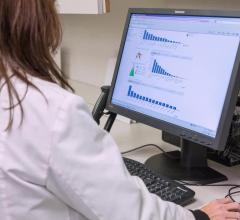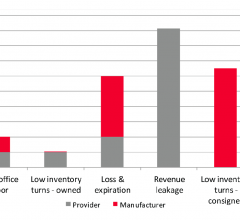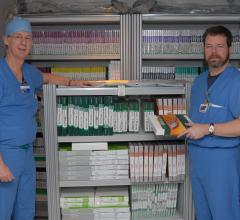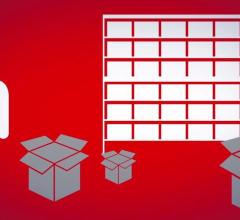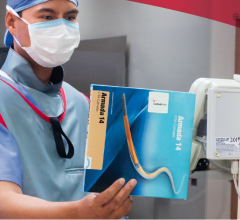May 21, 2008 - Hospitals are increasingly using real-time locating systems (RTLS) so clinicians know where to find the equipment they need or patients at any moment on a computerized map of the hospital. There are several technologies for RTLS tracking that use radio frequency identification (RFID), ultrasound or infrared emitting tags that are detected on a wireless network. RTLS systems can help hospitals increase staff efficiency by ending searches and phone calls looking for equipment. Knowing immediately where to find equipment also increases the efficient use of the devices, which can save money by reducing the need to purchase additional equipment. Spartanburg Regional Health Care System in Spartanburg, SC has been using McKesson's Horizon Real-Time Location System since 2006. It uses RFID tags that emit signals the hospital's WiFi network can pick up and show the location of the tagged item a computerized map, which is accessible at any hospital network computer. Equipment categories can be chosen from a drop-down menu to show all the current locations of those devices. Ray Shingler, Spartanburg's vice president of operations support and CIO, said the healthcare system became interested in RFID after hearing about Wal-Mart using it to track its inventory. After shopping around for an RTLS vendor, Shingler said he was dismayed to find many require a separate, proprietary WiFi network to be installed. Spartanburg could not justify the cost or extra hardware since it already had a WiFi system installed to connect its Vocera voice communication system, Cisco phones, computers on wheels and tablet PC networks. That was one of the big reasons why Spartanburg chose McKesson, which can install its Horizon RTLS on an existing WiFi system. The healthcare system has more than 100,000 medical devices in its inventory, which Shingler said would require a massive and expensive effort to tag and track all those devices. The tags cost about $40 each, he said. For that reason the system only tracks mobile equipment that is in high demand, expensive, or needs to be located instantly in emergencies. The list includes crash carts, infusion pumps, air hover mats used to transfer patients from beds to stretchers, ventilators and wheelchairs. About 1,100 pieces of equipment are tagged and tracked in the system. Prior to implementing the RTLS system nurses would try to ensure they had the equipment they needed and avoid searching room to room by hording things like infusion pumps, Shingler said. "Nurses are really dedicated to their cause and if they need a devices to do their job, they will tend to hide them so they know they have access to them," he explained. "Now we get comments all the time from our nurses thanking us for helping them do their job better by being able to find the equipment they need." The system has also saved the healthcare system money and paid for itself, Shingle said. "We were literally about to order $300,000 in new IV pumps when we realized we had enough pumps, but we had to be able to find them within our four walls," he said of discussions just prior to puchasing the RTLS system. "The nurses said if you know where to find them then we did not need to order more." Prior to RTLS the healthcare system was ordering 30 to 40 new wheelchairs. Since implementation Shingle said that number dropped, and last year none were ordered. Spartanburg uses RFID tags made by Ekahau, which Shingler said have a better battery life than other brands they used. The tags measure 1-by-¾-by-½ inches and have a battery life of about two years. He said the tags are attached to equipment and send out a radio frequency signal (chirp) when it is in motion. When it is stationary the tag stops chirping and the tracking system notes were the device is based on its last transmission. The time between chirps to verify a location can be adjusted, but the more chirps emitted, the shorter the battery life. The tags also have a small switch on them, which can be activated to alert biomed engineers the equipment needs servicing. The biomed department can also use the RTLS system to track and set up a maintenance schedule for individual devices, and to remotely check on each tag's battery power. The accuracy of the McKesson system allows a tag to be located within several feet of a general area, which is referred to as "room-level accuracy." Some RTLS manufacturers boast their systems can narrow a location down to a couple feet, or to "bed level accuracy" in multiple patient rooms. "People said you don't get a completely accurate location of exactly where something is using this system, but we really didn't care, as long as we knew what room it was in," Shingler said. When looking for an RFID system, Shingler suggests three things to keep in mind. First, make sure the system is designed with open architecture so it can connect easily to existing WiFi systems. "I don't know of any reason why you have to go with a proprietary system," he said. Second, Shingler said any RFID system that is being seriously reviewed should be measured by the staff members who will use it to make sure it will meet their needs. Third, an RFID system can help lower capital expenses by allowing better inventory control of a hospital's existing stock items being tracked, such as expensive medical devices. He said the cost of implementing an RFID system may be high, but the savings from not purchasing new equipment will help offset the cost. "It will help you reduce your capital expenditure and you will know where all your devices are at all times," Shingler said. Spartanburg is hoping to expand its use of RFID from equipment tracking to patient tracking later this year. Patients will be issued wristbands with small wristwatch-sized RFID transmitters so they can be tracked and located anywhere in the hospital. Spartanburg is currently working with McKesson to integrate its Horizon Surgical Manager perioperative system with RFID tags patients can wear so their progress in the OR can be monitored without making phone calls or tracking down staff, Shingler said. He said the system will also be able to track the efficiency of the OR and OR staff and be able to identify areas for workflow improvements. The perioperative RFID tracking system is expected to be operational by September.
If you enjoy this content, please share it with a colleague
RFID Tracking Can Help Increase Efficiency, Reduce Equipment Costs
Related Content
Tracking cardiovascular device inventory in cath labs, electrophysiology (EP) labs and operating rooms (ORs) can be a ...
The supplies you use in your cath lab are complex and very valuable. Protecting your investment and uncovering new ...
February 15, 2017 — Better hospital supply chain management leads to better quality of care and supports patient safety ...
The supply chain can serve as a critical strategic asset when addressing important initiatives tied to managing costs ...
Annual waste for high-value medical devices continues to grow at a rapid pace. With bundled payments putting increased ...
(Editors note: This article was written in 2014, and was updated with more recent information in January 2017.) ...
The healthcare industry’s transition to value-based care leaves no room for waste, and yet we know that inefficiency in ...
With quality of care and cost efficiency at the top of your mind, there is no room in your hospital for waste from high ...
As healthcare moves into the era of bundled payments, providers need to be especially focused on ensuring delivery of ...
With bundled payments putting increased pressure on hospitals to manage supply costs while providing quality patient ...


 April 28, 2017
April 28, 2017 
